Jame Mosque
(XVIII century)
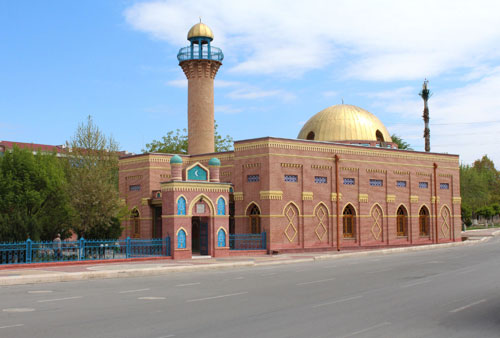
Mosques are the main parts of the architectural monuments built in Nakhchivan. One of these mosques that was used by Muslims as a place of worship and education is Jame Mosque. Jame Mosque is situated in the city center of Nakhchivan. Jame Mosque was built by Mahammad Tagi in XVIII century. It is also known as city mosque among the Nakhchivan people. During the Soviet Union, although the great propagating of atheism, Jame Mosque was the unique worship place functioned in Nakhchivan. The Mosque played a crucial role in socio-political and ideological life of the city before the Soviet Union.
When the 1000 square meter mosque was constructed, an inscription was put on the entrance door from the west side. In accordance to the inscription engraved on the marble plaque (size 87x57x12 cm), the mosque was built by the initiatives of Haji Novruzoglu Xeyrul-Haj Haji Mahammad Cefer aga at that time.
The mosque has one minaret. In 1918 when Armenians committed genocide against local people in Nakhchivan they damaged the minaret by artillery fire. This damage is clearly seen on the nature painting 1920 of distinguished artist Bahruz Kangarli.
In accordance to the order of the Chairman of the Supreme Assembly of Nakhchivan Autonomous Republic, restoration works were held in Jame Mosque in 2007.
Heydar Mosque
(1996)
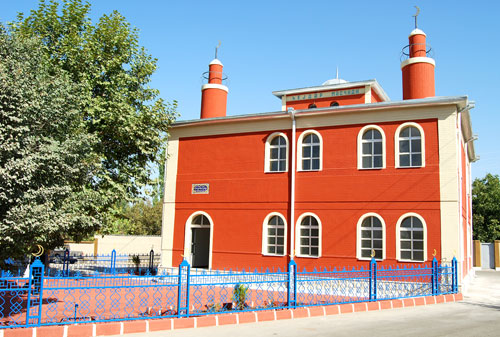
Heydar Mosque is one of the first mosques that were built in Nakhchivan Autonomous Republic during the period of independence. The Mosque is situated in the village of Ashagi Araliq of Sharur district. The two-storeyed mosque that has an original architectural design was built in 1996.
Resembling the oriental architectural elements, the mosque is situated in a 419 square meter territory. The total area of the mosque that was constructed in a modern design is 155 square meters. The yard of the mosque is surrounded by iron lattices decorated with the religious symbols and botanic and geometric designs. This mosque is named Heydar Mosque in honour of National Leader Haydar Aliyev."Heydar Mosque" with green glazed tiles in the dome and an inscription with Koran verses were engraved above the main entrance to the mosque.
The ground floor is 5 meters high, and the first floor is 3 meters high. The total height of the mosque is 10 meters. The mosque has got 4 pillars. 160 people, including 100 men and 60 women can worship in a one domed mosque at the same time. The mosque has got the minarets and they are of 15 meters high.
Sharur City Mosque
(2009)

After the restoration of independence of Azerbaijan a particular attention at the state level was paid to the construction of mosques in Nakhchivan Autonomous Republic and a number of new mosques have been built. One of these mosques is Sharur city mosque. The two-storeyed mosque in the city center of Sharur was built in 2009. Combining ancient and modern architectural traditions of the East, the total area of the mosque is 900 square meters, courtyard is 0.5 hectars. The height of the ground floor of the mosque is eight meters, the height of the first floor is three meters. The overall height of the mosque is twenty meters. There are four pillars. The mosque having 80 santimeters thick walls has three dome. 400 people including 100 women and 300 men can pray at the same time. The mosque has a hall and four rooms. The mosque with the entrance to the north-east has two minarets. The height of the minarets is 30 meters.
Jilovkhanli mosque
(XV century)
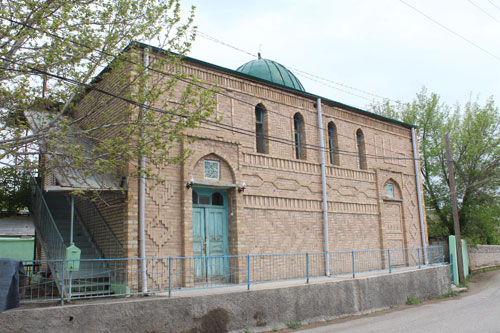
Mosques built in the villages have a special place among the samples of the Turco-Islamic culture existing during the Middle Ages in the territory of Autonomous Republic of Nakhchivan. One of these mosques is Jilovkhanlı mosque in Babek district.
The mosque built in the fifteenth century is situated in the Cilovkhanli street of the Jahri village of Babek district. It was built of stone, facade was covered with burnt bricks. The mosque consists of a great square-shaped hall. The first floor was made for women. Doors and windows from top were completed in the form of niches. The altar is a niche in the form of archs. Medieval glazed and unglazed ceramic products found around showed that the mosque was founded in the fifteenth century.
The mosque was restored in 1988.
Nehram Village Mosque
(2016)
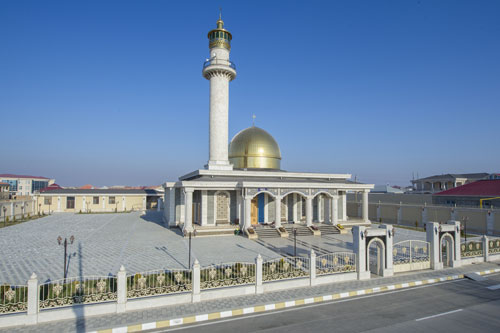
Nehram village mosque, built in oriental architectural style and commissioned in 2016, has its own place among mosques built in Nakhchivan during the period of independence.
The mosque is located in the Nehram village of Babek district. The total height of one-storeyed mosque is 6.5 meters. The total area is 350 square meters. It has four pillars. The thickness of the walls is 60 centimeters. The mosque has a dome. The height of the dome is 3.8 meters. 350 people including 170 women and 180 men can worship at the same time in the mosque. The mosque has an extra room besides the hall. The mosque with the entrance to the north-east has one minaret. The height of the minaret is 24 meters.
Heydar Mosque
(1996)

The Mosque situated in the village of Cheshmabasar, Babek district is one the mosques built in honor of National Leader Heydar Aliyev during the period of independence.
The height of ground floor of the two-storeyed mosque is 3 meters and the first floor is 2.5 meters high. The mosque is 6 meters high. The mosque located in a 72 square meter territory has got 4 stone pillars. The thickness of the walls of the mosque is 70 cm. 120 people can worship at the mosque at the same time. The entrance to the mosque is from the North. The Mosque has a minaret and a dome. The minaret is 12 meters high. An extra hall was built in the yard of the mosque for holding religious events.
The Mosque was renovated in 2015.
Girkh Kimsana Mosque
(XIV century)
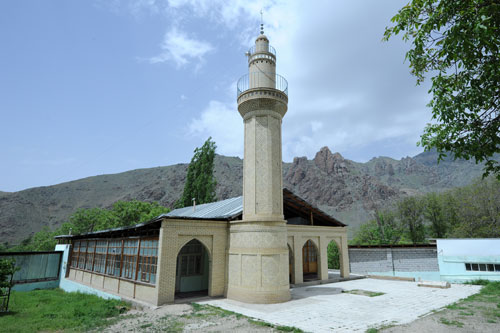
Girkh Kimsana Mosque, built in the XIV century, is one of the models of medieval Turco-Islamic cultural heritage of Nakhchivan. This mosque is situated in the village of Nusnus, Ordubad district, and called “Girk kimsana” by the indigenous people of Ordubad. This religious monument is used as a mosque and a place for pilgrimage. The mosque has got a 5 meter high stone pillar erecting from the ground floor to the top of the mosque.
In accordance to the descriptive information on the inscription placed over the entrance to the mosque, this sacred place was built by the adjutant of the ruler, Sadr Sarimoglu came from the dynasty of Sancar Aytekinoglu during the reign of Atabay Said Bahadir khan (1316-1335). The inscription was written on Tuesday, 4 Ramadan 726 Islamic (Hijri) Calendar (4.08.1326 CE). According to the information on the inscription, Nakhchivan was a part of the state of Hulaku till the decline of the state.
The mosque was renovated in 1993.
Ordubad Jame Mosque
(XVII century)

Jame mosques are the main sacred places built in the cities of Azerbaijan during the Middle Ages. Ordubad Jame Mosque is one of the most exquisite models of this kind of monuments due to attracting attention for its grandiose structure. Jame Mosque was built in the highest place in the city center of Ordubad in the XVII century.
The prayer hall situated in the center of the mosque stands out for its ancient history. Total inside area of the mosque is 400 square meters. The proof of the mosque constructed in an exquisite architectural design is placed on 5 meter high pillars. During the restoration works held in 1902, an extra hall was built in the western side of the mosque. This hall with a 25 meter length and a 6.5 meter width was built for women. The hall is lighted by windows. The inside walls were decorated with colourful calligraphies prepared on the alabaster consisting of the verses of Koran, religious short stories, texts and inscriptions. This kind of designs is found on the inside walls of halls and rooms in the mosque.
In accordance to the inscriptions made by Haji Mahammad Tagi Agaelioglu, during the restoration works held in the mosque, the calligraphic works were completed by Karbalayi Zeynalabidin Abdullazadeh. Construction and renovation works were conducted by Haji Mahammadqulu Aga Mirzebabaoglu. The decree (dates back to 1604) of Safavid Shah Abbas I on the tax exemption of the citizens of Ordubad was engraved on the inscription over the eastern entrance to the mosque.
The inscription found during the restoration works held in the mosque in 1902 proves that this monument was built in 111 Islamic (Hijri) Calendar (729). In other words, the mosque was constructed in the VIII century and reconstructed in the XVII century.
Abragunus Mosque
(2013)
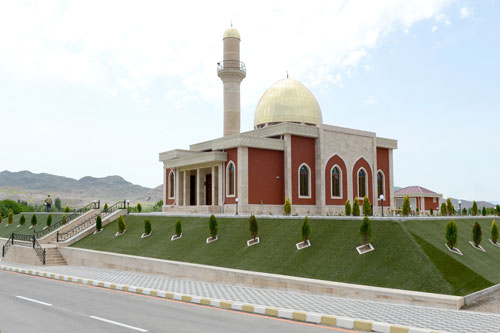
Abragunus mosque is one of the monuments built in the territory of Nakhchivan during the years of independence. The mosque is situated in the Abragunus village of Julfa district. The mosque was constructed by order and care of the Chairman of Supreme Assembly of Nakhchivan Autonomous Republic in 2013.
The mosque is one-storeyed and its total area is 320 square meters. It is 5.2 meter high and has four pillars. Thickness of walls is 40 centimeters. The mosque is one-domed and 220 people can pray at the same time. There are 4 rooms besides the main hall and entrance to the mosque is in the north. Mosque has got one minaret. The height of minaret is 24 meter. The mosque is provided with drinkable water from 1300 meter.


